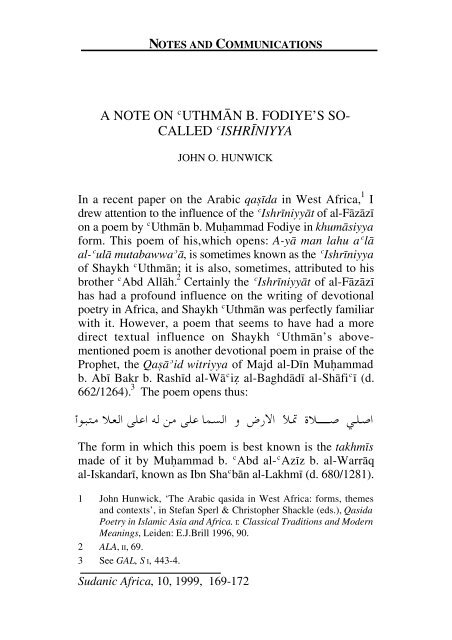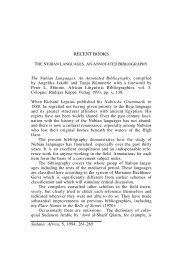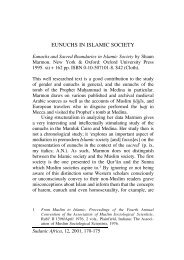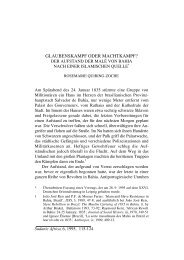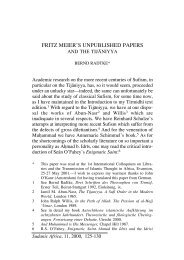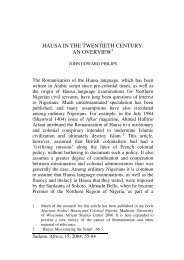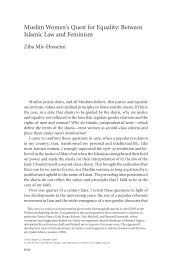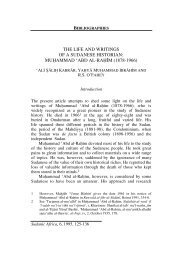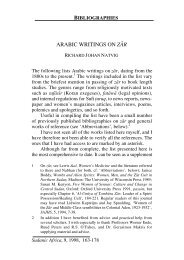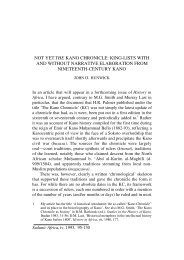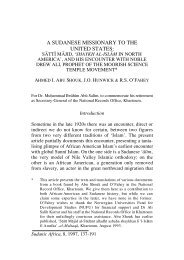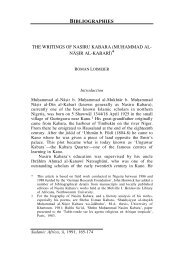Shehu Ishriniyya Nisus
Shehu Ishriniyya Nisus
Shehu Ishriniyya Nisus
Create successful ePaper yourself
Turn your PDF publications into a flip-book with our unique Google optimized e-Paper software.
NOTES AND COMMUNICATIONSA NOTE ON fiUTHM◊N B. FODIYE’S SO-CALLED fiISHRˆNIYYAJOHN O. HUNWICKIn a recent paper on the Arabic qaßıda in West Africa, 1 Idrew attention to the influence of the fiIshrıniyyapplet of al-Fapplezapplezıon a poem by fiUthmapplen b. Mu˛ammad Fodiye in khumapplesiyyaform. This poem of his,which opens: A-yapple man lahu afilappleal-fiulapple mutabawwa√apple, is sometimes known as the fiIshrıniyyaof Shaykh fiUthmapplen; it is also, sometimes, attributed to hisbrother fiAbd Allappleh. 2 Certainly the fiIshrıniyyapplet of al-Fapplezapplezıhas had a profound influence on the writing of devotionalpoetry in Africa, and Shaykh fiUthmapplen was perfectly familiarwith it. However, a poem that seems to have had a moredirect textual influence on Shaykh fiUthmapplen’s abovementionedpoem is another devotional poem in praise of theProphet, the Qaßapple√id witriyya of Majd al-Dın Mu˛ammadb. Abı Bakr b. Rashıd al-Wapplefii÷ al-Baghdappledı al-Shapplefifiı (d.662/1264). 3 The poem opens thus:√u?³²? ö?F« vKŽ« t s vKŽ UL«Ë ÷—ô« ú?9 …ö??????????????? w??K?«The form in which this poem is best known is the takhmısmade of it by Mu˛ammad b. fiAbd al-fiAzız b. al-Warrappleqal-Iskandarı, known as Ibn Shafibapplen al-Lakhmı (d. 680/1281).1 John Hunwick, ‘The Arabic qasida in West Africa: forms, themesand contexts’, in Stefan Sperl & Christopher Shackle (eds.), QasidaPoetry in Islamic Asia and Africa. I: Classical Traditions and ModernMeanings, Leiden: E.J.Brill 1996, 90.2 ALA, II, 69.3 See GAL, S I, 443-4.Sudanic Africa, 10, 1999, 169-172
170 NOTES AND COMMUNICATIONSAccording to his introduction to the takhmıs, the poethad seen the Prophet in a dream circumambulating the Kafiba.The Prophet had showed him a copy of the Witriyya, andasked him what he thought of it. Ibn Shafibapplen asked permissionto make a takhmıs of it, and the Prophet so authorized him.When he awoke he began his rendering of the poem inquintains.The original poem contains twenty-one lines for eachrhyming letter of the alphabet. Ibn Shafibapplen produces threehemistichs to add before each line of the original poem—thequintain consisting of five hemistichs. Thus the first completequintain reads: 4 U??b??I? U??Šb?? §« d??cÐ √bÐU‡‡L?EF? «dJý §« b?L??×Ð wMŁ«ËU?L?«Ë ÷—ô« ú9 …ö? wK«√u???³???²?? ö???F« v?KŽ« t s v?KŽU‡?‡/≈Ë …ö?‡‡?‡B?UÐ w?u???? r²?????š«ËThe total numer of quintains is thus 546, consisting of 2,730hemistiches. This version was well known to the Fulanischolars of north-western Nigeria at the turn of the nineteenthcentury. The Shaykh’s brother fiAbd Allappleh mentions it amongthe works he had studied. 5A comparison of the opening quintain of ShaykhfiUthmapplen’s poem with certain lines of the first section (˛arfal-alif) of the Witriyya, reveals the close influence of theone on the other:4 The edition used was published by Maktabat wa-Ma†bafiat al-Mashhadal-˘usaynı, Cairo 1383/1962.5 See M. Hiskett, ‘The state of learning among the Fulani before theirjihappled’, Bulletin of the School of Oriental and African Studies, xix,1957, 565.
NOTES AND COMMUNICATIONS 171Shaykh fiUthmapplen’s fiIshrıniyya, v. 1:Witriyya, v. 1:Shaykh fiUthmapplen’s fiIshrıniyya, v. 2:Witriyya, v. 2:Shaykh fiUthmapplen’s fiIshrıniyya, v. 3:Witriyya, v. 16:√u³² öF« vKŽ« t s ô«√u³² öF« vKŽ« t s vKŽììwK«QÞuð ‰ö'« V−Š t s ô«QÞuð ‰ö'« V−Š t X«Ë√u{« fLA« s tłË t s ô«√u{« fLA« s tłË t s v« ììwuA𠜫“Shaykh fiUthmapplen’s fiIshrıniyya, v. 4:Witriyya, v. 21:Shaykh fiUthmapplen’s fiIshrıniyya, v. 5:Witriyya, v. 7:Q−K p½« wðôeÐ p²Oð«Q−K pNłË dOG UË XOIýQAM „«– s X½« w½dł« wM¦ž«QAM V×K X½« »UŠ dOGÐìì U½ƒUDŽ «c¼Although by Western canons of originality this might looklike plagiarism, in the Islamic tradition to which this belongs,
172 NOTES AND COMMUNICATIONSit would merely be seen as reflecting Shaykh fiUthmapplen’sadmiration for Ibn Shafibapplen’s poem, and perhaps as a meansof drawing not merely inspiration from it, but baraka.


